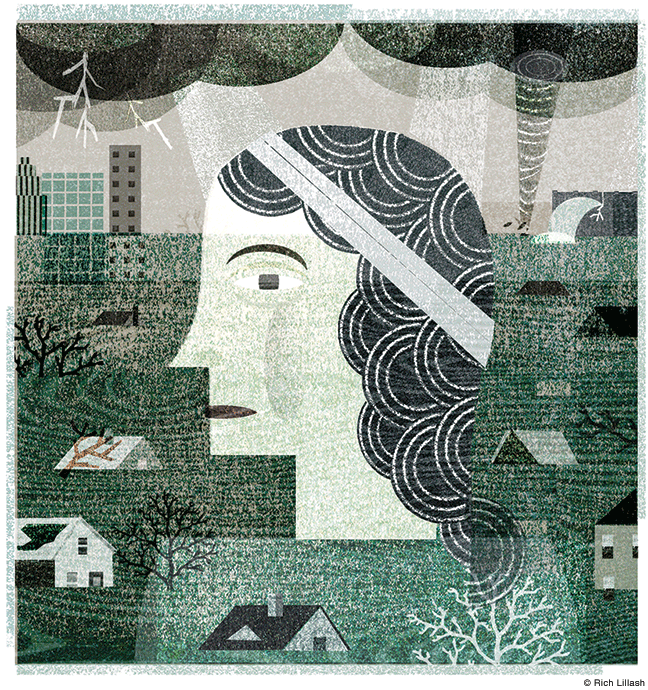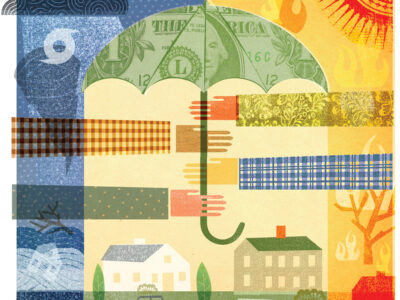
Prophets of disaster are often ignored—even when their predictions prove accurate. We stand to gain from heeding the right ones.
BY RICHARD CLARKE
Have you ever noticed how often an investigation after a disaster turns up someone, an expert, who saw it coming but was ignored? That question led me to examine, along with my coauthor R. P. Eddy, whether there is a high occurrence of such rejections of experts’ warnings. What if we could identify and heed people who accurately warn of impending catastrophes before the calamity occurs?
Our examination of case studies from a variety of fields suggests that there is a regular pattern of experts’ accurate predictive warnings being ignored or unheeded. We call these predictors Cassandras, after the Greek mythological figure who was cursed by the gods to see the future but forever have her predictions ignored. Moreover, we think there are common attributes among the Cassandras and the issues they discuss that should allow us to distinguish in advance whether the prediction is coming from someone likely to be right, or if it is the baseless fearmongering of a Chicken Little.
Our case studies range from a seasoned US diplomat who predicted the rise of ISIS years in advance, to a quiet Japanese seismologist warning of the Fukushima Daiichi nuclear meltdown, to a Boston accountant warning of the impending collapse of the Madoff investment fund. All were ignored. Two of the more well-known Cassandras are Ivor van Heerden and James Hansen. Van Heerden, a native of South Africa who studied marine sciences, wetland, and coastal management, received his PhD from Louisiana State University. He became deputy director of the LSU Hurricane Center in 1998 and began modeling hurricane storm surge for the Greater New Orleans metropolitan area. He concluded that the New Orleans levee system was nowhere near adequate to withstand a hurricane as powerful as the one that would later be known as Katrina. August of 2005 saw Hurricane Katrina ravage southern Louisiana and Mississippi, and even though officials were reluctant to concede that van Heerden’s warning had been accurate, in the public’s eyes, he was proven right.
James Hansen also warns of a flood, but this one will be global. Hansen emerged from the University of Iowa as a physicist and astronomer in his youth, but spent the next few decades making a name for himself in the realm of atmospheric and climate science at the NASA Goddard Institute for Space Studies. He was one of the first to sound the alarm about global climate change, publishing his first major paper on the subject in 1981. In the midst of the North American drought of 1988, Congress held hearings and asked Hansen to testify. He said that the climate was changing, and that it was the fault of human action. It was not a strong statement for us today, but in an era when the oil industry was almost entirely unchallenged, Hansen’s testimony was considered so radical that the White House issued a gag order on him. Then, as the climate changed as he predicted, he was acknowledged to have been right.
Now, three decades later, he is making a new prediction: that sea level rise will happen much quicker and will be far worse than the UN’s International Panel on Climate Change predicts. Hansen cites the Eemian Interglacial period, which lasted from 130,000 to 115,000 years ago and was only about 1 degree Celcius warmer than today, as a historical analogue that illuminates what civilization can expect if human-caused warming continues. The Eemian period featured extreme storms and sea levels 5–9 meters higher than what we see today. This amount of sea-level rise would spell the end for cities like Miami, Boston, New York, and Washington, barring the expenditure of hundreds of billions of dollars on new infrastructure. Hansen thinks that we could see this in as soon as 50 years’ time.
Using the past case studies, we developed a template we call the Cassandra Coefficient that examines the person giving the prediction, the nature of the issue, the decision-makers, and the critics. Among the more powerful determinants of whether or not an expert has been ignored are cognitive biases based on ideology, existing agendas, the magnitude of the problem, and the apparently unprecedented nature of the event foretold (“That’s never happened”).
We then apply that process to present day predictions of impending disaster in areas including artificial intelligence, CRISPR-Cas9 gene editing, nuclear proliferation, asteroid impacts, the Internet of Things, and antibiotic-resistant disease.
Reliably listening for and identifying warnings requires an institutional solution. In our experience, the typical decision-maker in any organization has a demanding job that leaves little time to regularly conduct broad searches for additional problems. The United States needs an office whose specific mission is future forecasting and warning. Some parts of the government already have processes for identifying future problems; the US Public Health Service, for example, has the little known but highly important Epidemic Intelligence Service, whose staff are popularly known as “disease detectives” and look for new and emerging diseases. Most of the time, however, a government department or agency sets up an office to address a specific problem only after someone discovers it.
We advocate a formalized National Warning Office, housed in the Executive Office of the President, which could serve as a focal point for identifying disasters on the horizon. It would have a broad, even intentionally vague, mandate to look across all departmental boundaries for new and emerging threats. It should not address ongoing problems, such as obesity. Rather, the focus should be on possible impending disasters that are not being addressed by any part of government. It should also work on two institutional goals: first, to create management and decision-making environments that nurture, rather than stamp out, dissent and warning from qualified experts; and second, to develop a small cadre of people drawn from every cabinet agency to establish processes and information sharing to recognize sentinel intelligence.
What our case studies of possible future disasters suggest is that today we are not acting on the expert advice of those who are very likely to be right. If we listen to them and act on their warnings we could avoid, or at least mitigate, future catastrophes. Thus, we need a system in our institutions, nationally and globally, to identify Cassandra and listen to her warnings. Can you hear her?





While I sincerely hope you will not be ignored as a cassandra, have you also considered the statistical effect of the number of experts who give forecasts?
For example it would be easy for me to creata blog for every major city on the planet and issue a forecast warning of an extreme economic downturn. I would be right in a few cities, nut should nonetheless be ignored and not hailed as a genius.